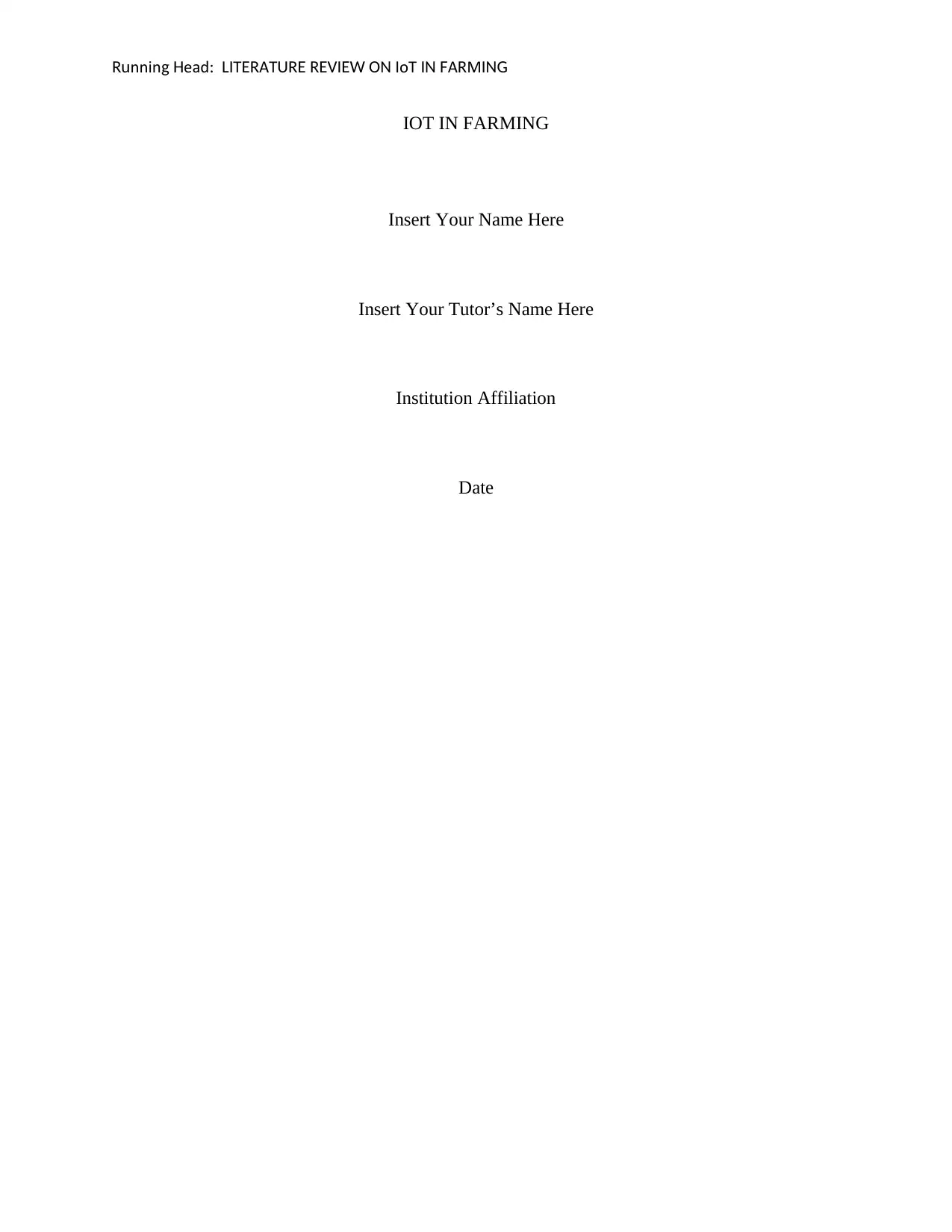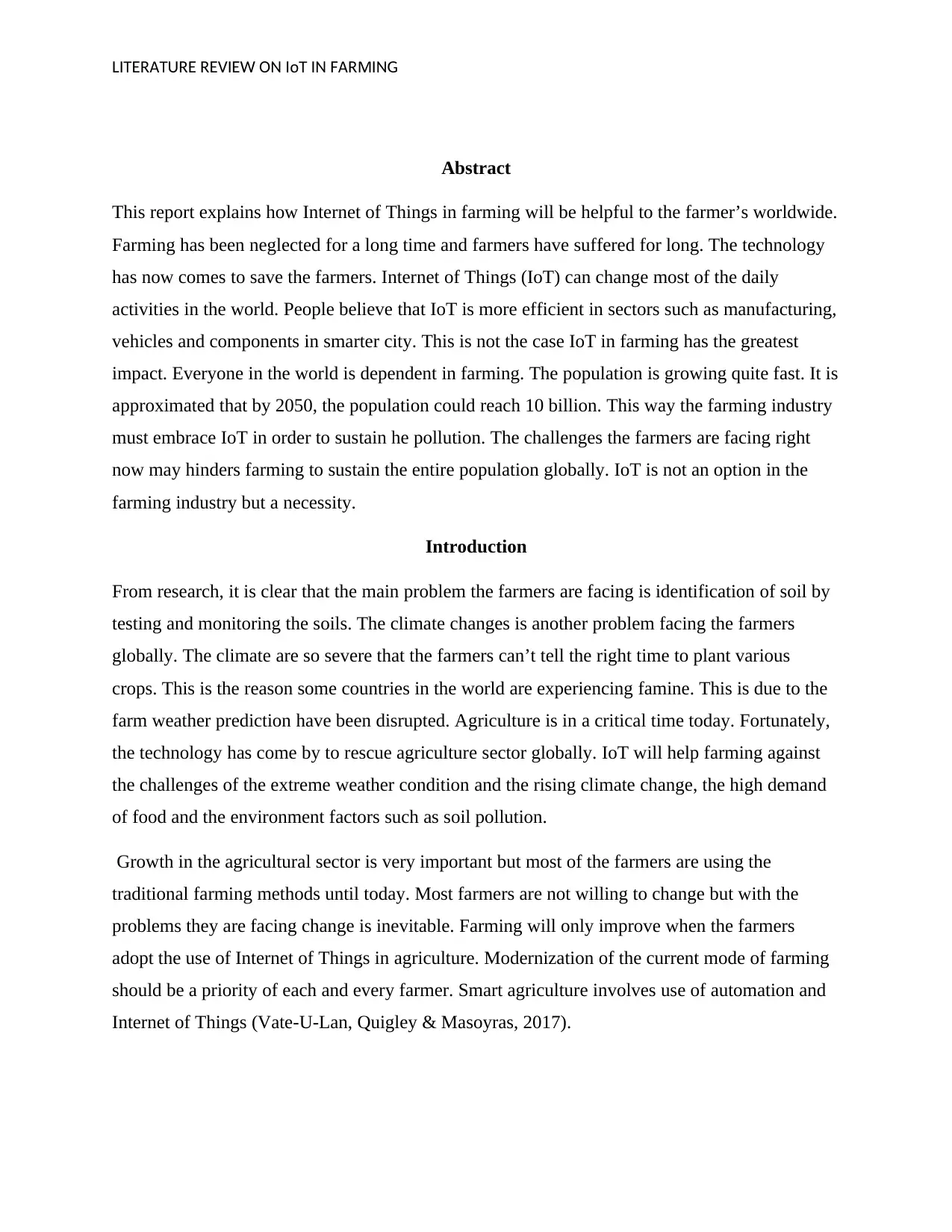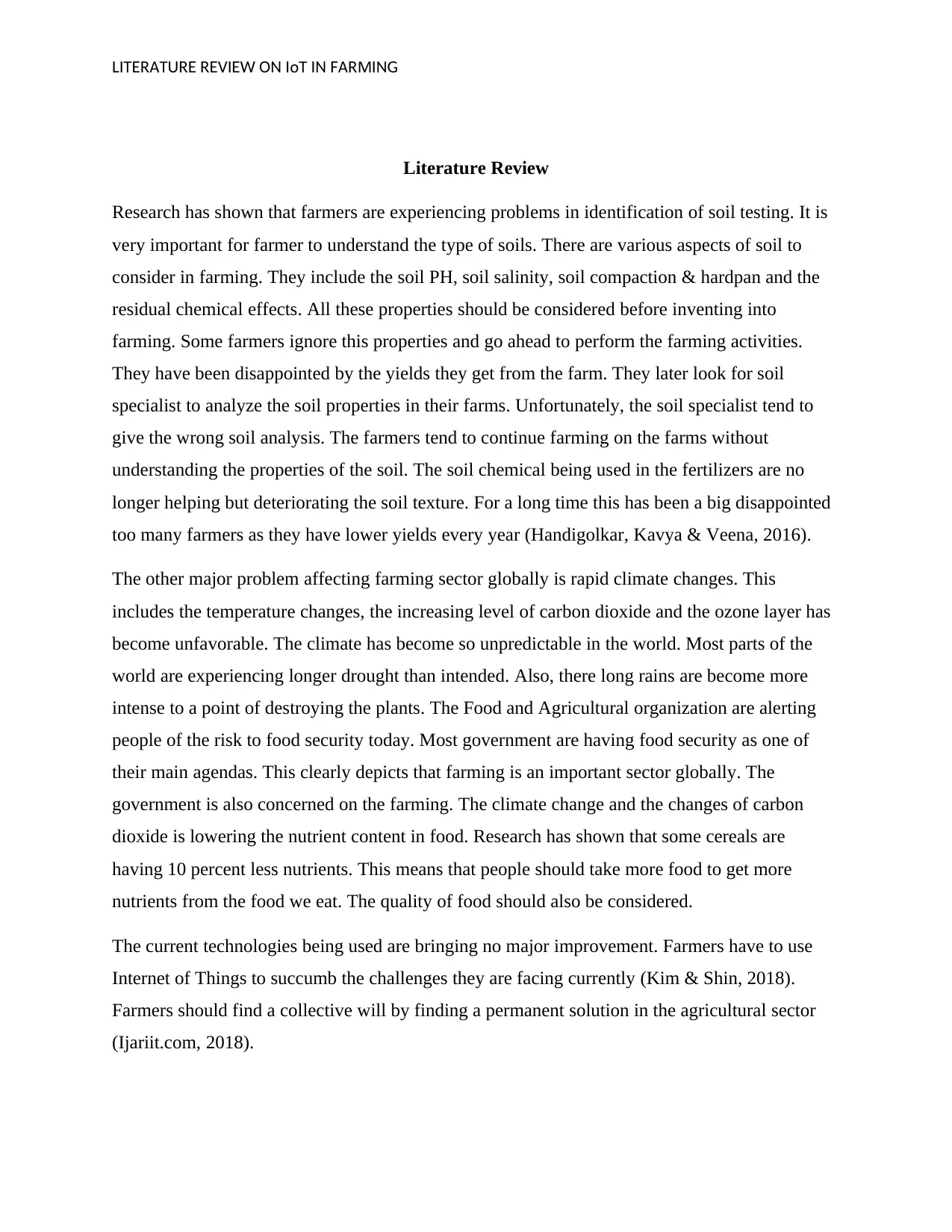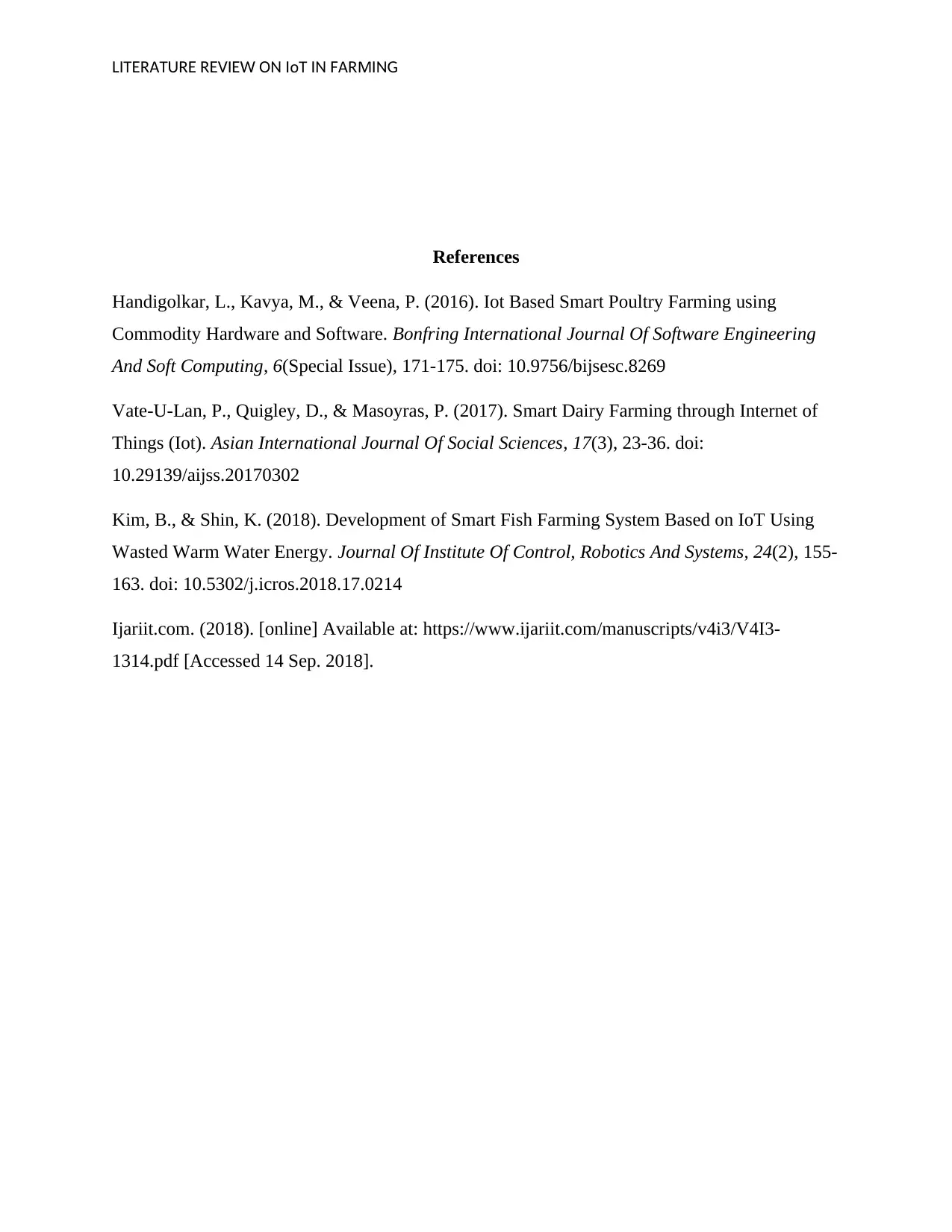IoT in Farming: A Literature Review
VerifiedAdded on 2023/06/06
|4
|1026
|111
AI Summary
This report explains how Internet of Things in farming will be helpful to the farmer’s worldwide. IoT will help farming against the challenges of the extreme weather condition and the rising climate change, the high demand of food and the environment factors such as soil pollution.
Contribute Materials
Your contribution can guide someone’s learning journey. Share your
documents today.

nnin ead T AT oT A MRu g H : LI ER URE REVIEW ON I IN F R ING
IOT IN FARMING
Insert Your Name Here
Insert Your Tutor’s Name Here
Institution Affiliation
Date
IOT IN FARMING
Insert Your Name Here
Insert Your Tutor’s Name Here
Institution Affiliation
Date
Secure Best Marks with AI Grader
Need help grading? Try our AI Grader for instant feedback on your assignments.

T AT oT A MLI ER URE REVIEW ON I IN F R ING
Abstract
This report explains how Internet of Things in farming will be helpful to the farmer’s worldwide.
Farming has been neglected for a long time and farmers have suffered for long. The technology
has now comes to save the farmers. Internet of Things (IoT) can change most of the daily
activities in the world. People believe that IoT is more efficient in sectors such as manufacturing,
vehicles and components in smarter city. This is not the case IoT in farming has the greatest
impact. Everyone in the world is dependent in farming. The population is growing quite fast. It is
approximated that by 2050, the population could reach 10 billion. This way the farming industry
must embrace IoT in order to sustain he pollution. The challenges the farmers are facing right
now may hinders farming to sustain the entire population globally. IoT is not an option in the
farming industry but a necessity.
Introduction
From research, it is clear that the main problem the farmers are facing is identification of soil by
testing and monitoring the soils. The climate changes is another problem facing the farmers
globally. The climate are so severe that the farmers can’t tell the right time to plant various
crops. This is the reason some countries in the world are experiencing famine. This is due to the
farm weather prediction have been disrupted. Agriculture is in a critical time today. Fortunately,
the technology has come by to rescue agriculture sector globally. IoT will help farming against
the challenges of the extreme weather condition and the rising climate change, the high demand
of food and the environment factors such as soil pollution.
Growth in the agricultural sector is very important but most of the farmers are using the
traditional farming methods until today. Most farmers are not willing to change but with the
problems they are facing change is inevitable. Farming will only improve when the farmers
adopt the use of Internet of Things in agriculture. Modernization of the current mode of farming
should be a priority of each and every farmer. Smart agriculture involves use of automation and
Internet of Things (Vate-U-Lan, Quigley & Masoyras, 2017).
Abstract
This report explains how Internet of Things in farming will be helpful to the farmer’s worldwide.
Farming has been neglected for a long time and farmers have suffered for long. The technology
has now comes to save the farmers. Internet of Things (IoT) can change most of the daily
activities in the world. People believe that IoT is more efficient in sectors such as manufacturing,
vehicles and components in smarter city. This is not the case IoT in farming has the greatest
impact. Everyone in the world is dependent in farming. The population is growing quite fast. It is
approximated that by 2050, the population could reach 10 billion. This way the farming industry
must embrace IoT in order to sustain he pollution. The challenges the farmers are facing right
now may hinders farming to sustain the entire population globally. IoT is not an option in the
farming industry but a necessity.
Introduction
From research, it is clear that the main problem the farmers are facing is identification of soil by
testing and monitoring the soils. The climate changes is another problem facing the farmers
globally. The climate are so severe that the farmers can’t tell the right time to plant various
crops. This is the reason some countries in the world are experiencing famine. This is due to the
farm weather prediction have been disrupted. Agriculture is in a critical time today. Fortunately,
the technology has come by to rescue agriculture sector globally. IoT will help farming against
the challenges of the extreme weather condition and the rising climate change, the high demand
of food and the environment factors such as soil pollution.
Growth in the agricultural sector is very important but most of the farmers are using the
traditional farming methods until today. Most farmers are not willing to change but with the
problems they are facing change is inevitable. Farming will only improve when the farmers
adopt the use of Internet of Things in agriculture. Modernization of the current mode of farming
should be a priority of each and every farmer. Smart agriculture involves use of automation and
Internet of Things (Vate-U-Lan, Quigley & Masoyras, 2017).

T AT oT A MLI ER URE REVIEW ON I IN F R ING
Literature Review
Research has shown that farmers are experiencing problems in identification of soil testing. It is
very important for farmer to understand the type of soils. There are various aspects of soil to
consider in farming. They include the soil PH, soil salinity, soil compaction & hardpan and the
residual chemical effects. All these properties should be considered before inventing into
farming. Some farmers ignore this properties and go ahead to perform the farming activities.
They have been disappointed by the yields they get from the farm. They later look for soil
specialist to analyze the soil properties in their farms. Unfortunately, the soil specialist tend to
give the wrong soil analysis. The farmers tend to continue farming on the farms without
understanding the properties of the soil. The soil chemical being used in the fertilizers are no
longer helping but deteriorating the soil texture. For a long time this has been a big disappointed
too many farmers as they have lower yields every year (Handigolkar, Kavya & Veena, 2016).
The other major problem affecting farming sector globally is rapid climate changes. This
includes the temperature changes, the increasing level of carbon dioxide and the ozone layer has
become unfavorable. The climate has become so unpredictable in the world. Most parts of the
world are experiencing longer drought than intended. Also, there long rains are become more
intense to a point of destroying the plants. The Food and Agricultural organization are alerting
people of the risk to food security today. Most government are having food security as one of
their main agendas. This clearly depicts that farming is an important sector globally. The
government is also concerned on the farming. The climate change and the changes of carbon
dioxide is lowering the nutrient content in food. Research has shown that some cereals are
having 10 percent less nutrients. This means that people should take more food to get more
nutrients from the food we eat. The quality of food should also be considered.
The current technologies being used are bringing no major improvement. Farmers have to use
Internet of Things to succumb the challenges they are facing currently (Kim & Shin, 2018).
Farmers should find a collective will by finding a permanent solution in the agricultural sector
(Ijariit.com, 2018).
Literature Review
Research has shown that farmers are experiencing problems in identification of soil testing. It is
very important for farmer to understand the type of soils. There are various aspects of soil to
consider in farming. They include the soil PH, soil salinity, soil compaction & hardpan and the
residual chemical effects. All these properties should be considered before inventing into
farming. Some farmers ignore this properties and go ahead to perform the farming activities.
They have been disappointed by the yields they get from the farm. They later look for soil
specialist to analyze the soil properties in their farms. Unfortunately, the soil specialist tend to
give the wrong soil analysis. The farmers tend to continue farming on the farms without
understanding the properties of the soil. The soil chemical being used in the fertilizers are no
longer helping but deteriorating the soil texture. For a long time this has been a big disappointed
too many farmers as they have lower yields every year (Handigolkar, Kavya & Veena, 2016).
The other major problem affecting farming sector globally is rapid climate changes. This
includes the temperature changes, the increasing level of carbon dioxide and the ozone layer has
become unfavorable. The climate has become so unpredictable in the world. Most parts of the
world are experiencing longer drought than intended. Also, there long rains are become more
intense to a point of destroying the plants. The Food and Agricultural organization are alerting
people of the risk to food security today. Most government are having food security as one of
their main agendas. This clearly depicts that farming is an important sector globally. The
government is also concerned on the farming. The climate change and the changes of carbon
dioxide is lowering the nutrient content in food. Research has shown that some cereals are
having 10 percent less nutrients. This means that people should take more food to get more
nutrients from the food we eat. The quality of food should also be considered.
The current technologies being used are bringing no major improvement. Farmers have to use
Internet of Things to succumb the challenges they are facing currently (Kim & Shin, 2018).
Farmers should find a collective will by finding a permanent solution in the agricultural sector
(Ijariit.com, 2018).

T AT oT A MLI ER URE REVIEW ON I IN F R ING
References
Handigolkar, L., Kavya, M., & Veena, P. (2016). Iot Based Smart Poultry Farming using
Commodity Hardware and Software. Bonfring International Journal Of Software Engineering
And Soft Computing, 6(Special Issue), 171-175. doi: 10.9756/bijsesc.8269
Vate-U-Lan, P., Quigley, D., & Masoyras, P. (2017). Smart Dairy Farming through Internet of
Things (Iot). Asian International Journal Of Social Sciences, 17(3), 23-36. doi:
10.29139/aijss.20170302
Kim, B., & Shin, K. (2018). Development of Smart Fish Farming System Based on IoT Using
Wasted Warm Water Energy. Journal Of Institute Of Control, Robotics And Systems, 24(2), 155-
163. doi: 10.5302/j.icros.2018.17.0214
Ijariit.com. (2018). [online] Available at: https://www.ijariit.com/manuscripts/v4i3/V4I3-
1314.pdf [Accessed 14 Sep. 2018].
References
Handigolkar, L., Kavya, M., & Veena, P. (2016). Iot Based Smart Poultry Farming using
Commodity Hardware and Software. Bonfring International Journal Of Software Engineering
And Soft Computing, 6(Special Issue), 171-175. doi: 10.9756/bijsesc.8269
Vate-U-Lan, P., Quigley, D., & Masoyras, P. (2017). Smart Dairy Farming through Internet of
Things (Iot). Asian International Journal Of Social Sciences, 17(3), 23-36. doi:
10.29139/aijss.20170302
Kim, B., & Shin, K. (2018). Development of Smart Fish Farming System Based on IoT Using
Wasted Warm Water Energy. Journal Of Institute Of Control, Robotics And Systems, 24(2), 155-
163. doi: 10.5302/j.icros.2018.17.0214
Ijariit.com. (2018). [online] Available at: https://www.ijariit.com/manuscripts/v4i3/V4I3-
1314.pdf [Accessed 14 Sep. 2018].
1 out of 4
Related Documents
Your All-in-One AI-Powered Toolkit for Academic Success.
+13062052269
info@desklib.com
Available 24*7 on WhatsApp / Email
![[object Object]](/_next/static/media/star-bottom.7253800d.svg)
Unlock your academic potential
© 2024 | Zucol Services PVT LTD | All rights reserved.





